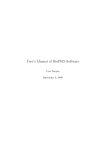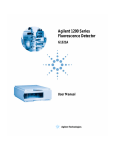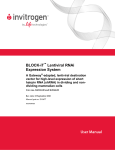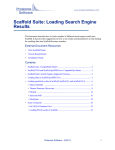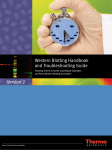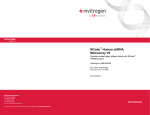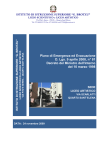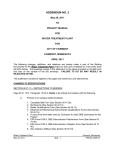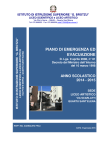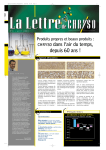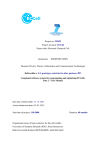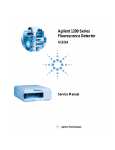Download Transfecting Cells
Transcript
BioModule™ Transfection and Control Unit with BLOCK-iT™ Technology For delivery of Stealth™ RNAi or siRNA into mammalian cells for RNAi analysis Catalog no. WFGE06 Version A 6 December 2005 25-0882 Corporate Headquarters Invitrogen Corporation 1600 Faraday Avenue Carlsbad, CA 92008 T: 1 760 603 7200 F: 1 760 602 6500 E: [email protected] For country-specific contact information visit our web site at www.invitrogen.com User Manual ii Table of Contents Table of Contents ................................................................................................................................................. iii Experienced Users Procedure ............................................................................................................................. v Kit Contents and Storage .................................................................................................................................... vi Introduction ................................................................................................................... 1 Overview.................................................................................................................................................................1 Description of Components..................................................................................................................................5 Experimental Overview ........................................................................................................................................8 Methods ....................................................................................................................... 10 General Guidelines ..............................................................................................................................................10 Transfecting Cells ................................................................................................................................................14 Expected Results ..................................................................................................................................................20 Troubleshooting ...................................................................................................................................................22 Appendix...................................................................................................................... 24 Technical Service..................................................................................................................................................24 Product Qualification ..........................................................................................................................................25 Accessory Products..............................................................................................................................................26 Purchaser Notification ........................................................................................................................................28 References .............................................................................................................................................................30 iii iv Experienced Users Procedure Introduction A brief experienced user’s procedure for transfecting Stealth™ RNAi or siRNA molecules into mammalian cells using Lipofectamine™ 2000 Reagent is described below. Refer to this manual for a detailed protocol. Step Procedure Preparing Cells Grow your mammalian cell line of choice in the recommended medium. Use low-passage cells, and make sure that cells are healthy and greater than 90% viable before transfection. Amount of RNAi to Transfect The recommended starting amount of each duplex used for transfection is listed below. To achieve optimal target gene knockdown, you may need to experimentally determine the amount of RNAi required for each mammalian cell line. Recommended Conc. Duplex ™ Stealth RNAi or siRNA 40 nM ™ Stealth RNAi Negative Control Duplex ™ BLOCK-iT Fluorescent Oligo Perform Transfection 40 nM 100 nM ™ Use this procedure to transfect Stealth RNAi or siRNA into mammalian cells in a 24-well format. All amounts and volumes are given on a per well basis. For other formats, see Scaling Up or Down Transfections (page 18). Use this procedure as a starting point and optimize transfections as described below. 1. One day before transfection, plate cells in 500 µl of growth medium without antibiotics such that they will be 30-50% confluent at the time of transfection. 2. For each transfection sample, prepare as follows: a. Dilute 20 pmol (1 µl of 20 µM solution) Stealth™ RNAi or siRNA oligomer in 50 µl Opti-MEM® I Reduced Serum Medium without serum (resulting concentration of RNA is 40 nM). Mix gently. b. Dilute 60 pmol (3 µl of 20 µM solution) BLOCK-iT™ Fluorescent Oligo in 50 µl Opti-MEM® I Reduced Serum Medium without serum (resulting concentration of the Fluorescent Oligo is 100 nM). Mix gently. c. Mix Lipofectamine™ 2000 gently before use, then dilute 1 µl in 50 µl Opti-MEM® I Reduced Serum Medium. Mix gently and incubate for 5 minutes at room temperature. d. After the 5-minute incubation, combine the diluted oligomer with the diluted Lipofectamine™ 2000. Mix gently and incubate for 20 minutes at room temperature (solution may appear cloudy). Optimizing Transfection 3. Add the oligomer-Lipofectamine™ 2000 complexes to each well containing cells and medium. Mix gently by rocking the plate back and forth. 4. Incubate the cells at 37°C in a CO2 incubator for 24-96 hours until you are ready to assay for gene knockdown. Medium may be changed after 4-6 hours. To obtain the highest transfection efficiency and low non-specific effects, optimize transfection conditions as described below. • Use a range of 0.5 µl to 1.5 µl Lipofectamine™ 2000 Reagent for 24-well format. • Use a range of 20-100 nM Stealth™ RNAi or siRNA for 24-well format. • Depending on the nature of the target gene, you may transfect cells at higher densities. v Kit Contents and Storage Shipping and Storage The shipping conditions for each component are listed in the table below. Upon receipt, store the components as described below. Components Shipping Storage ™ Blue ice 4ºC (do not freeze) BLOCK-iT Fluorescent Oligo Blue ice -20ºC (protect from light) Stealth RNAi Negative Control Duplex (Medium GC ) Dry ice -20ºC Opti-MEM® I Reduced Serum Medium Room temperature 2ºC to 8ºC (in the dark) Lipofectamine 2000 Reagent ™ ™ Kit Contents The components included with the BioModule™ Transfection and Control Unit with BLOCK-iT™ Technology are described below. Box Item 1 2-3 ™ Lipofectamine 2000 Reagent ™ BLOCK-iT Fluorescent Oligo Composition Amount Proprietary formulation 0.75 ml 20 µM stock of fluorescein-labeled doublestranded RNA (dsRNA) oligomer in: 2 x 125 µl 100 mM potassium acetate 30 mM HEPES-KOH, pH 7.4 2 mM Magnesium acetate 4 5 ™ Stealth RNAi Negative Control Duplex (Medium GC ) 20 µM in 1X RNA Annealing/Dilution Buffer 250 µl 1X RNA Annealing/Dilution Buffer 10 mM Tris-HCl, pH 8.0, 20 mM NaCl, 1 mM EDTA, pH 8.0 1 ml Opti-MEM® I Reduced Serum Medium See below for formulation 100 ml Formulation of Opti-MEM® I Reduced Serum Medium vi Opti-MEM® I Reduced Serum Medium is a modification of Eagle's Minimal Essential Medium, buffered with HEPES and sodium bicarbonate, and supplemented with hypoxanthine, thymidine, sodium pyruvate, L-glutamine or GLUTAMAX™, trace elements, and growth factors. The protein level is minimal (15 μg/ml); insulin and transferrin are the only protein supplements. Phenol red is included at a reduced concentration as a pH indicator. • Some reagents in the unit may be provided in excess of the amount needed. • Individual documentation detailing general use are included with some of the products supplied in the BioModule™ Transfection and Control Unit. To use the products specifically with the BioModule™ Transfection and Control Unit, follow the recommended protocols in this manual. Introduction Overview Introduction The BioModule™ Transfection and Control Unit with BLOCK-iT™ Technology provides qualified reagents and validated protocols to deliver Stealth™ RNAi (see page 3 for details) or siRNA (short interfering RNA) molecules into mammalian cells for RNA interference (RNAi) studies. The BioModule™ Transfection and Control Unit provides reagents and controls required to perform transfection and assess transfection efficiency for RNAi analysis in mammalian cell lines. The BLOCK-iT™ Technology is a next generation RNAi technology employing synthetic Stealth™ RNAi or expression vectors containing an RNAi cassette to perform RNAi studies in mammalian cells. A variety of RNAi products with BLOCK-iT™ Technology are available from Invitrogen to facilitate RNAi analysis. For more information, visit the RNAi Central portal at www.invitrogen.com/rnai or contact Technical Service (page 24). BioModule™ Units for Gene Expression Profiling The BioModule™ Transfection and Control Unit with BLOCK-iT™ Technology is one of the several BioModule™ Units available from Invitrogen (page 26) for gene expression profiling. Each of the BioModule™ Units for gene expression profiling includes high-quality reagents and validated protocols with relevant controls for each step of the workflow (see below). Each unit is designed to provide an integrated workflow that allows you to perform various steps seamlessly during expression analysis. Gene expression profiling comprises multiple steps employing various technologies such as microarray analysis or quantitative PCR (qPCR) for analysis at the nucleic acid level; western immunodetection and immunohistochemistry for analysis at the protein level; and RNAi for functional analysis. Identify changes in gene expression profiles Microarray Analysis Analysis of gene function Synthetic and Vector-based RNAi qPCR Analysis Quantitative measurement of RNA transcripts Western Detection or IHC Staining Protein detection from cells and tissues Continued on next page 1 Overview, Continued System Components The BioModule™ Transfection and Control Unit includes: • Lipofectamine™ 2000 Reagent for highly efficient delivery of dsRNA oligomers into a wide variety of mammalian cells • BLOCK-iT™ Fluorescent Oligo, a fluorescein-labeled double-stranded RNA (dsRNA) oligomer for use as an indicator of transfection efficiency in RNAi experiments with Stealth™ RNA or siRNA • Stealth™ RNAi Negative Control Duplex (Medium GC) for use as a negative control for the RNAi response • Opti-MEM® I Reduced Serum Medium is a multi-purpose, proven medium used for diluting the Lipofectamine™ 2000 Reagent and nucleic acid during transfection. The medium is also useful in reducing serum requirements for a wide variety of cell lines and applications, and has been effective in the growth and maintenance of adherent and non-adherent cell lines • 1X RNA Annealing/Dilution Buffer for use in diluting RNAi molecules for transfection, if necessary For more information about each component, see page 5. System Overview To use the BioModule™ Transfection and Control Unit, you will: • Obtain synthetic Stealth™ RNAi or siRNA duplex to the target gene of interest • Transfect mammalian cell line of choice with the Stealth™ RNAi or siRNA using Lipofectamine™ 2000 Reagent and Opti-MEM® I Reduced Serum Medium • Assay for gene knockdown using an assay of choice Continued on next page 2 Overview, Continued Uses for the BioModule™ Transfection and Control Unit Stealth™ RNAi Use the BioModule™ Transfection and Control Unit with BLOCK-iT™ Technology in your RNAi experiments for the following purposes: • Use Lipofectamine™ 2000 Reagent for highly efficient delivery of dsRNA oligomers including the BLOCK-iT™ Fluorescent Oligo and Stealth™ RNAi or standard siRNA into your mammalian cell line of interest for RNAi analysis. • Include the BLOCK-iT™ Fluorescent Oligo in your RNAi experiments to help you optimize your transfection conditions and to assess transfection efficiency in your mammalian cell line. Once you have optimized your transfection conditions, include the BLOCK-iT™ Fluorescent Oligo in every RNAi experiment as an indicator of transfection efficiency. • If you are transfecting RNAi molecules into a mammalian cell line of interest for the first time, use the reagents provided to help you optimize your transfection conditions. Stealth™ RNAi is chemically modified, blunt end dsRNA developed to overcome the limitations of traditional siRNA. The two strands of Stealth™ RNAi are modified in a manner that prevents sense strand activity, eliminating sense strand mediated-off-target activity. The Stealth™ RNAi interacts with the RNAi machinery to elicit gene silencing, similar to traditional siRNA. See next page for a description of the RNAi pathway. Using Stealth™ RNAi for RNAi analysis offers the following advantages: • Obtain effective target gene knockdown at levels that are equivalent to or greater than those achieved with traditional siRNA • Reduces non-specific effects caused by induction of cellular stress response pathways • Exhibits enhanced stability for greater flexibility in RNAi analysis A large variety of ready-to-order, pre-designed Stealth™ RNAi products are available from Invitrogen to facilitate RNAi analysis (page 27) or you may design and order custom Stealth™ RNAi for any target gene of interest using the BLOCKiT™ RNAi Designer from Invitrogen (www.invitrogen.com/rnaidesigner). Continued on next page 3 Overview, Continued RNAi Pathway RNAi describes the phenomenon by which dsRNA induces potent and specific inhibition of eukaryotic gene expression via the degradation of complementary messenger RNA (mRNA), and is functionally similar to the processes of posttranscriptional gene silencing (PTGS) or cosuppression in plants (Cogoni et al., 1994; Napoli et al., 1990; Smith et al., 1990; van der Krol et al., 1990) and quelling in fungi (Cogoni & Macino, 1997; Cogoni & Macino, 1999; Romano & Macino, 1992). In plants, the PTGS response is thought to occur as a natural defense against viral infection or transposon insertion (Anandalakshmi et al., 1998; Jones et al., 1998; Li & Ding, 2001; Voinnet et al., 1999). In eukaryotic organisms, dsRNA produced in vivo or introduced by pathogens is processed into 21-23 nucleotide double-stranded short interfering RNA duplexes (siRNA) by an enzyme called Dicer, a member of the RNase III family of doublestranded RNA-specific endonucleases (Bernstein et al., 2001; Ketting et al., 2001). The siRNA is then incorporated into an RNA-induced silencing complex (RISC), an enzyme complex that serves to target cellular transcripts complementary to the siRNA for specific cleavage and degradation (Hammond et al., 2000; Nykanen et al., 2001). In addition to dsRNA, other endogenous RNA molecules including short temporal RNA (stRNA) and micro RNA (miRNA) (Ambros, 2001; Carrington & Ambros, 2003) have been identified and shown to be capable of triggering gene silencing. For more information about the RNAi pathway, refer to recent reviews (Bosher & Labouesse, 2000; Dykxhoorn et al., 2003; Hannon, 2002; Plasterk & Ketting, 2000; Zamore, 2001). Purpose of this Manual This manual provides the following information: • An overview of Stealth™ RNAi and the RNAi pathway • General guidelines for transfection and performing expression/screening assays • Transfection protocol for transfecting the Stealth™ RNAi or siRNA duplex into mammalian cells for RNAi analysis • Example of expected results • Troubleshooting Protocols for screening or expression assays are not included in this manual. 4 Description of Components Introduction Brief description of the components included with the BioModule™ Transfection and Control Unit with BLOCK-iT™ Technology is described in this section. Lipofectamine™ 2000 Reagent Lipofectamine™ 2000 Reagent is a proprietary formulation for the delivery of the BLOCK-iT™ Fluorescent Oligo and Stealth™ RNAi or standard siRNA oligomers to mammalian cells for RNAi analysis (Gitlin et al., 2002; Yu et al., 2002). Using Lipofectamine™ 2000 to transfect eukaryotic cells offers the following advantages: Stealth™ RNAi Negative Control Duplex • Highest transfection efficiency in many cell types and formats (e.g. 96-well). Refer to the Cell Lines database at www.invitrogen.com for a list of cell types successfully transfected. • Nucleic acid-Lipofectamine™ 2000 complexes can be added directly to cells in culture medium, in the presence or absence of serum. • It is not necessary to remove complexes or change/add medium after transfection, but complexes may be removed after 4-6 hours. Stealth™ RNAi Negative Control Duplex (Medium GC) is ideal for use in RNA interference (RNAi) experiments as a control for sequence independent effects following Stealth™ RNAi delivery in any vertebrate cell line. The Stealth™ RNAi Negative Control Duplex is designed to minimize sequence homology to any known vertebrate transcript, does not induce the interferonmediated stress response pathways as measured by real-time quantitative RTPCR, and demonstrates minimal knockdown of vertebrate target genes. The Stealth™ RNAi Negative Control Duplex (Medium GC) contains 48% GC content and is suitable for use with Stealth™ RNAi duplexes containing 45-55% GC. The Stealth™ RNAi Negative Control Duplex is supplied in a ready-to-use format. BLOCK-iT™ Fluorescent Oligo The BLOCK-iT™ Fluorescent Oligo is a fluorescein-labeled dsRNA oligomer designed for use in RNAi analysis to facilitate assessment and optimization of cationic lipid-mediated delivery or electroporation of dsRNA oligonucleotides into mammalian cells. Using the BLOCK-iT™ Fluorescent Oligo in RNAi studies offers the following advantages: • Provides a good indication of the transfection efficiency with Invitrogen’s Stealth™ RNAi, standard unmodified siRNA, or purified Dicer-generated siRNA. • Allows strong, easy fluorescence-based indication of transfection efficiency in every RNAi experiment. Continued on next page 5 Description of Components, Continued Characteristics of the BLOCK-iT™ Fluorescent Oligo The BLOCK-iT™ Fluorescent Oligo possesses the following characteristics: • Is a fluorescein-labeled, double-stranded RNA duplex with the same length, charge, and configuration as standard siRNA. • Contains chemical modifications that enhance the stability and allow assessment of fluorescence signal for a significantly longer time period than is obtained with other unmodified, fluorescently labeled RNA. Example: Fluorescence signal is readily detectable in HEK293 cells for at least 72 hours. Note that the strength of the fluorescence signal depends on the transfection efficiency and growth rate of the cells. • • The sequence of the BLOCK-iT™ Fluorescent Oligo is not homologous to any known gene, ensuring against induction of non-specific cellular events caused by introduction of the Oligo into cells. Localizes primarily to the nucleus upon uptake ((Fisher et al., 1993)). For examples of fluorescent uptake in adherent (panel A) and suspension (panel B) cells, see the figure below. Important: The BLOCK-iT™ Fluorescent Oligo is designed strictly for use as a tool for siRNA uptake assessment, and is not meant to provide any information about the behavior of your Stealth™ RNAi or siRNA including its cellular localization, half-life, or stability. Continued on next page 6 Description of Components, Continued Opti-MEM® I Reduced Serum Medium Opti-MEM® I Reduced Serum Medium is a versatile, chemically-defined medium used for diluting the lipid and nucleic acid during transfection. The Opti-MEM® I Reduced Serum Medium is a multi-purpose medium proven to be useful in reducing serum requirements for a wide variety of cell lines and applications and has been effective in the growth and maintenance of adherent and non-adherent cell lines. When supplemented with 2-4% fetal bovine serum or alternative sera, Opti-MEM® I Reduced Serum Medium supports proliferative rates and maximal cell densities comparable to, and in some cases superior to, conventional media supplemented with 10% fetal bovine serum. Relatively nonfastidious cell lines may be maintained in long-term culture with even more substantial serum reduction. If using adherent cell lines and less than 2% serum supplementation or in an agitated system such as in roller bottles, the medium should be further supplemented with 100 mg/l CaCl2. The versatility of Opti-MEM® I Reduced Serum Medium in the propagation of various cell types makes this medium the optimal choice for many cell culture requirements. For details on using the medium to reduce serum requirements for various cell lines, download the Opti-MEM® I Reduced Serum Medium manual from www.invitrogen.com. 1X RNA Annealing/Dilution Buffer is supplied with the kit for use in diluting 1X RNA Annealing/Dilution RNAi molecules, if necessary. For an RNAi molecule, the concentration of reagent required to induce effective target gene knockdown (if the RNAi molecule is Buffer active) can vary with each mammalian cell line and requires optimization. When optimizing your transfection conditions, use the 1X RNA Annealing/Dilution Buffer to dilute the RNAi reagent stock solution, if needed. 7 Experimental Overview Workflow The experimental workflow for using the BioModule™ Transfection and Control Unit BLOCK-iT™ Technology is shown below. Use BLOCK-iT™ RNAi Designer and RNAi Express to design and order RNAi duplexes to mammalian targets ™ Obtain Stealth RNAi or siRNA duplex Prepare Cells Perform transfection using Lipofectamine™ 2000 Reagent Perform screening assay after 24-96 hours Analyze data Validate results using OR qPCR Analysis Immunohistochemistry Analysis OR Western Analysis Any other functional assay Continued on next page 8 Experimental Overview, Continued Materials Needed You will need the following materials: • Stealth™ RNAi or siRNA duplex of choice (supplied by the user, see page 10 for details) • Lipofectamine™ 2000 Reagent (supplied with the kit) • Opti-MEM® I Reduced Serum Medium (supplied with the kit) • BLOCK-iT™ Fluorescent Oligo (supplied with the kit) • Stealth™ RNAi Negative Control Duplex, medium GC (supplied with the kit) • Mammalian cell line of choice (supplied by the user) • Cell culture media and cell culture plates (supplied by the user) 9 Methods General Guidelines Introduction General guidelines for using the BioModule™ Transfection and Control Unit are described in this section. Review the information in this section prior to performing the transfection and screening experiments to obtain the best results. To use the BioModule™ Transfection and Control Unit effectively, we recommend that you have a working knowledge of the RNAi pathway, designing appropriate screening assays, performing transfections and screening assays, and analyzing screening assay data to identify significant hits. RNAi Molecules To use the BioModule™ Transfection and Control Unit, you need to synthesize or purchase Stealth™ RNAi or siRNA molecules to your target gene of interest for performing RNAi analysis. To obtain highly specific, effective gene knockdown and eliminate non-specific effects, we recommend that you use Stealth™ RNAi. For more information on Stealth™ RNAi, see page 3. To obtain RNAi molecules, you may: • Purchase pre-designed Stealth™ RNAi (see next page) Choose from a large selection of pre-designed Stealth™ RNAi from Invitrogen. • Synthesize Stealth™ RNAi or siRNA duplexes If a Stealth™ RNAi molecule of choice is not available from our collection of pre-designed Stealth™ RNAi, use the BLOCK-iT™ RNAi Designer, an online tool from Invitrogen (www.invitrogen.com/rnaidesigner), to help you design and order custom Stealth™ RNAi or traditional, unmodified siRNA molecules for any target gene of interest. The RNAi Designer incorporates published rules on RNAi design into a proprietary algorithm to design most effective RNAi sequences to obtain high level gene knockdown. Continued on next page 10 General Guidelines, Continued Stealth™ RNAi Products A large variety of ready-to-order, pre-designed Stealth™ RNAi products are available from Invitrogen to facilitate RNAi analysis. Use the BLOCK-iT™ RNAi Express Search Engine (www.invitrogen.com/RNAiExpress) to search for a Stealth™ RNAi duplex of choice by gene name, GenBank accession number, or keyword. The search results are linked directly to the ordering page, allowing you to easily order the RNAi molecule of choice. Validated Stealth™ RNAi The Validated Stealth™ RNAi DuoPak includes two highly effective, functionally tested Stealth™ RNAi molecules designed for in vitro and in vivo RNAi analysis of a particular human target gene. Each Validated Stealth™ RNAi duplex is supplied in a ready-to-use format and targets a different region of the human gene of interest, demonstrating ≥ 80% target gene knockdown. Stealth™ Select RNAi The Stealth™ Select RNAi are highly effective pre-designed Stealth™ RNAi molecules available individually or as a set of three non-overlapping sequences to thousands of human, mouse, or rat genes. For each set of three Stealth™ Select RNAi, 2 out of 3 RNAi sequences are guaranteed to knockdown transcript levels by at least 70%. Stealth™ RNAi Collections The Stealth™ RNAi Collections combine the power of chemical modification with advanced in silico design algorithms to provide you with an advanced RNAi collection suited for RNAi studies. A large variety of Stealth™ RNAi Collections are available from Invitrogen. Each Stealth™ RNAi Collection is composed of three, non-overlapping Stealth™ RNAi duplexes designed to target human or mouse genes that are arrayed in 96-well format for high-throughput gene silencing screening experiments. Cell Lines Stealth™ RNAi is designed for use with species specific cell lines only. Using non-species specific cell lines will not produce the desired level of target gene knockdown. For example, use the Stealth™ RNAi designed for human targets with human cell lines only. Using mouse or rat cell lines will not produce the desired level of target gene knockdown. Transfection The BioModule™ Transfection and Control Unit includes Lipofectamine™ 2000 Reagent for delivery of dsRNA oligomers to mammalian cells for transfection. An optimized transfection protocol for mammalian cells is described on page 17. However, depending on your cell type, you may need to optimize the transfection conditions such as cell number, amount of the transfection reagent and RNAi, and the time period to assay for target gene knockdown to obtain the best results. Cell-type specific RNAi transfection protocols are also available at www.invitrogen.com/rnai. Continued on next page 11 General Guidelines, Continued Factors Affecting Gene Knockdown Levels A number of factors can influence the degree to which expression of your gene of interest is reduced (i.e. gene knockdown) in an RNAi experiment including: • Transfection efficiency • Transcription rate of the target gene of interest • Stability of the target protein • Growth characteristics of your mammalian cell line Take these factors into account when designing your RNAi experiments. Performing an Assay for Target Gene Knockdown To validate your Stealth™ RNAi or siRNA, you must measure the effect of the RNAi molecule on the target mRNA using a screening assay. A screening assay usually measures the target mRNA expression or target gene expression depending on the assay. Examples of screening assays include: • Cell proliferation assays using the CyQUANT® Cell Proliferation Assay Kit (page 26) • Quantitative RT-PCR (qRT-PCR) • Signal transduction pathway analysis using CellSensor™ Cell Lines (page 27) • Reporter based target screening system such as the BLOCK-iT™ RNAi Target Screening System with lacZ reporter (page 26) • Protein expression assay using enzyme activity, immunocytochemistry, immunohistochemistry, western blotting, or ELISA Prior to performing RNAi experiments, select a suitable screening assay to measure gene knockdown and optimize the assay to obtain the best results. Choose a screening assay with the following criteria: • High sensitivity • Low background • Signal stability • Fast, efficient, easy to perform If you are measuring protein levels to analyze the Stealth™ RNAi or siRNAmediated inhibition, any pre-existing pool of the protein must be degraded. If the protein of interest has a long half-life, you may need to perform long-term transfection experiments (i.e. perform multiple cycles of transfection) to observe effects at the protein level. Note: The Stealth™ RNAi or siRNA may be effective at decreasing mRNA levels of the target gene; however, may not affect protein levels if the target protein has a long halflife. If possible, measure mRNA and protein level to confirm the effect of Stealth™ RNAi or siRNA on gene knockdown. Continued on next page 12 General Guidelines, Continued Appropriate Controls When performing RNAi analysis, it is important to include proper positive and negative controls to help evaluate your results. The BLOCK-iT™ Fluorescent Oligo and Stealth™ RNAi Negative Control Duplex are included in the BioModule™ Transfection and Control Unit for your convenience. Use the BLOCK-iT™ Fluorescent Oligo as an indicator of transfection efficiency with Stealth™ RNAi or siRNA using any fluorescence microscope with a standard FITC filter set. Be sure to include your assay specific controls and controls for mock or untransfected cells. 13 Transfecting Cells MEND ION AT RECOM Introduction This section provides guidelines to transfect the Stealth™ RNAi or siRNA into the mammalian cell line of interest to perform RNAi analysis. • We recommend Opti-MEM® I Reduced Serum Medium to dilute Lipofectamine™ 2000 Reagent and RNAi duplexes before complexing. • Do not add antibiotics to media during transfection as this causes cell death. • Use low-passage cells, and make sure that cells are healthy and greater than 90% viable before transfection. • Maintain the same seeding conditions between experiments. • Transfect cells at 30-50% confluence. Transfecting cells at a lower density allows a longer time interval to elapse between transfection and assay time, and minimizes the loss of cell viability due to cell overgrowth. Depending on the nature of the target gene, transfecting cells at higher densities may be suitable with optimization of conditions. • To increase accuracy and reduce assay variability, we recommend performing triplicate transfections for each sample condition. • We recommend assessing BLOCK-iT™ Fluorescent Oligo uptake at 6-24 hours post-transfection; however, assay target gene knockdown levels (following Stealth™ RNAi or siRNA delivery) at a minimum of 24-72 hours following transfection. You may also assay for target gene knockdown at various time points such as 24, 48, 72, 96 hours post-transfection. • Determine the appropriate amount of BLOCK-iT™ Fluorescent Oligo to use such that fluorescence signal is readily detectable. For recommended reagent amounts to use, see page 17. Note: Once you have determined optimal transfection conditions using the BLOCK-iT™ Fluorescent Oligo, you may use these conditions as a starting point to transfect Stealth™ RNAi or siRNA, with optimization as necessary. Handling the Stealth™ RNAi Negative Control Duplex • Test serum-free media for compatibility with Lipofectamine™ 2000 Reagent since some serum-free formulations (e.g. CD293, SFM II, VP-SFM) may inhibit cationic lipid-mediated transfection. • Thaw Stealth™ RNAi Negative Control Duplex stock solution on ice or at room temperature. After use, return to -20°C storage. • Multiple freeze/thaw cycles are permitted without loss of activity if stock solution is handled properly. • Ensure that the stock solution does not become contaminated with RNase. Continued on next page 14 Transfecting Cells, Continued Handling the BLOCK-iT™ Fluorescent Oligo The BLOCK-iT™ Fluorescent Oligo is supplied as a 20 µM stock solution in an annealing buffer. Follow the guidelines below when handling the BLOCK-iT™ Fluorescent Oligo stock solution. • The BLOCK-iT™ Fluorescent Oligo is light sensitive. Store the stock solution at -20°C, protected from light. The stock solution is stable for at least 6 months if stored properly. • When using, thaw the stock solution on ice or at room temperature. Once thawed, place the tube on ice until use. After use, return stock solution to -20°C storage. • The stock solution may be frozen and thawed multiple times without loss of fluorescence signal if handled properly. • Take precautions to ensure that the stock solution does not become contaminated with RNase. a. Use RNase-free sterile pipette tips and supplies for all manipulations. b. Wear gloves when handling reagents and solutions. Using the BLOCKiT™ Fluorescent Oligo Use the BLOCK-iT™ Fluorescent Oligo with Lipofectamine™ 2000 Reagent for delivery of Stealth™ RNAi or siRNA to mammalian cells. Follow the guidelines below when transfecting the BLOCK-iT™ Fluorescent Oligo. • The amount of BLOCK-iT™ Fluorescent Oligo to use depends on the growth rate and transfection efficiency of the mammalian cells. If you are transfecting your mammalian cell line for the first time, we recommend evaluating several concentrations of lipid and varying the final concentration of the BLOCK-iT™ Fluorescent Oligo from 10 to 200 nM to determine the optimal amount of BLOCK-iT™ Fluorescent Oligo to use to obtain a strong fluorescence signal. Note: For most cell lines tested (e.g. HEK293, A549, HeLa), we obtain a readily detectable fluorescence signal when using 100 nM BLOCK-iT™ Fluorescent Oligo for transfection. • Prepare lipid-BLOCK-iT™ Fluorescent Oligo complexes as directed on page 17. Always dilute the BLOCK-iT™ Fluorescent Oligo immediately before transfection (i.e. do not store diluted Oligo) into Opti-MEM® I Reduced Serum Medium. Continued on next page 15 Transfecting Cells, Continued Amount of RNAi to The amount of Stealth™ RNAi or siRNA duplex, BLOCK-iT™ Fluorescent Oligo, or the Stealth™ RNAi Negative Control Duplex required to achieve optimal Transfect target gene knockdown or minimal knockdown, as appropriate, should be determined experimentally for each mammalian cell line. The recommended starting amount of each duplex used for transfection is listed in the table below: Recommended Conc. Duplex ™ Stealth RNAi or siRNA ™ Stealth RNAi Negative Control Duplex ™ BLOCK-iT Fluorescent Oligo 40 nM 40 nM 100 nM Based on the initial results, you may need to optimize transfection conditions as described on page 18. Materials Needed You will need the following materials: • Mammalian cell line of interest cultured in the appropriate growth medium • Lipofectamine™ 2000 Reagent (supplied with the kit, store at 4ºC until use) • Opti-MEM® I Reduced Serum Medium (supplied with the kit, pre-warm to 37ºC before use) • Stealth™ RNAi or siRNA duplex (20 µM in 1X RNA Annealing Buffer) • BLOCK-iT™ Fluorescent Oligo (supplied with the kit; 20 µM in 1X RNA Annealing Buffer) • Stealth™ RNAi Negative Control Duplex (supplied with the kit, 20 µM in 1X RNA Annealing Buffer) • Appropriate tissue culture plates and supplies • Appropriate user designed controls Continued on next page 16 Transfecting Cells, Continued Transfection Protocol • Use the transfection procedure described below as a starting point; optimize transfections as described in Optimizing Transfection (page 18), especially if you are transfecting a mammalian cell line for the first time. • To reduce well-to-well variability when transfecting multiple replicates (e.g. triplicates), proportionally scale up the reagent volumes to form complexes (Step 2, below), then aliquot an equal volume of complexes into each well. • Prepare Stealth™ RNAi or siRNA duplex at a concentration of 20 µM in 1X RNA Annealing Buffer. 20 µM Stealth™ RNAi or siRNA = 20 pmol/µl. Use this procedure to transfect Stealth™ RNAi or siRNA into mammalian cells in a 24-well format. All amounts and volumes are given on a per well basis. For other formats, see Scaling Up or Down Transfections (page 18). 1. One day before transfection, plate cells in 500 µl of growth medium without antibiotics such that they will be 30-50% confluent at the time of transfection. Note: Transfecting cells at a lower density allows a longer interval between transfection and assay time, and minimizes the loss of cell viability due to cell overgrowth. 2. For each transfection sample, prepare oligomer-Lipofectamine™ 2000 complexes as follows: a. Dilute 20 pmol Stealth™ RNAi or siRNA oligomer (i.e. 1 µl of 20 µM Stealth™ RNAi or siRNA oligomer) in 50 µl Opti-MEM® I Reduced Serum Medium without serum (resulting concentration of RNA is 40 nM). Mix gently. b. Dilute 60 pmol BLOCK-iT™ Fluorescent Oligo (i.e. 3 µl of 20 µM Fluorescent Oligo) in 50 µl Opti-MEM® I Reduced Serum Medium without serum (resulting concentration of the Fluorescent Oligo is 100 nM). Mix gently. c. Mix Lipofectamine™ 2000 gently before use, then dilute 1 µl in 50 µl OptiMEM® I Reduced Serum Medium. Mix gently and incubate for 5 minutes at room temperature. Note: Combine diluted Lipofectamine™ 2000 with diluted RNA within 30 minutes. d. After the 5-minute incubation, combine the diluted oligomer with the diluted Lipofectamine™ 2000 (total volume is ~100 µl). Mix gently and incubate for 20 minutes at room temperature (solution may appear cloudy). 3. Add the oligomer-Lipofectamine™ 2000 complexes to each well containing cells and medium. Mix gently by rocking the plate back and forth. 4. Incubate the cells at 37°C in a CO2 incubator for 24-96 hours until you are ready to assay for target gene knockdown. Assess BLOCK-iT™ Fluorescent Oligo uptake at 6-24 hours post-transfection. Medium may be changed after 4-6 hours. An example of gene knockdown results are shown on page 20. Continued on next page 17 Transfecting Cells, Continued Optimizing Transfection Scaling Up or Down Transfections To obtain the highest transfection efficiency and low non-specific effects, optimize transfection conditions by varying RNA and Lipofectamine™ 2000 Reagent concentrations. • 1 µl Lipofectamine™ 2000 Reagent per well is recommended as a starting point but optimization of transfection conditions may be required. A range of 0.5 µl to 1.5 µl Lipofectamine™ 2000 Reagent is recommended for 24-well format. • 40 nM Stealth™ RNAi is recommended as a starting point but you can use a range from 20-100 nM Stealth™ RNAi for 24-well format. • Depending on the nature of the target gene, transfecting cells at higher densities may also be considered when optimizing conditions. • Note that for RNAi molecules inducing >90% target knockdown, the amount of dsRNA required to obtain effective knockdown may be less than the amount specified. This needs to be determined empirically for each cell line. To transfect cells in different tissue culture formats, vary the amounts of Lipofectamine™ 2000, nucleic acid, cells, and medium used in proportion to the relative surface area, as shown in the table. With automated, high-throughput systems, a complexing volume of 50 µl is recommended for transfections in 96-well plates. Tip: 20 µM Stealth™ RNAi or siRNA = 20 pmol/µl. Note: You may perform rapid 96-well plate transfections by plating cells directly into the transfection mix. Prepare complexes in the plate and directly add cells at twice the cell density as in the basic protocol in a 100 µl volume. Cells will adhere as usual in the presence of complexes. 96-well Volume of plating medium 100 µl 24-well 2 cm2 500 µl 20 pmol in 50 µl 1.0 µl in 50 µl 12-well 4 cm2 1 ml 40 pmol in 100 µl 2.0 µl in 100 µl 6-well 10 cm2 2 ml 100 pmol in 250 µl 5 µl in 250 µl 2 5 ml 200 pmol in 0.5 ml 10 µl in 0.5 ml 2 15 ml 600 pmol in 1.5 ml 30 µl in 1.5 ml 60-mm 10-cm 1 RNAi (pmol) in media Lipofectamine™ 2000 (µl) in media volume (µl) volume (µl) 5 pmol in 25 µl 0.25 µl in 25 µl Surface Area per well1 0.3 cm2 Culture vessel 20 cm 60 cm Surface areas may vary depending on the manufacturer. Continued on next page 18 Transfecting Cells, Continued Detecting Fluorescence If you have transfected your mammalian cells with the BLOCK-iT™ Fluorescent Oligo, you may qualitatively assess Oligo uptake in live cells 6-24 hours posttransfection using fluorescence microscopy. You may use any type of fluorescence microscope and a standard FITC filter set (λex = 494 nm, λem = 519 nm green) for detection. An example of expected results is shown on page 20. The Next Step Once you have assessed the gene knockdown, we recommend that you validate the results using additional methods such as qPCR, Western analysis, immunohistochemistry, or any other functional assay. A variety of BioModule™ Units that include qualified reagents and validated protocols are available from Invitrogen to perform further validation experiments (page 26). 19 Expected Results Example of Results An example of results obtained after performing an RNAi experiment using the BioModule™ Transfection and Control Unit with BLOCK-iT™ Technology and validation using western immunodetection with the BioModule™ Western Analysis are shown below. In this experiment, A549 cells were transfected with MAPK1 Validated Stealth™ RNAi Duopak (2 different duplexes) targeting MAP Kinase 1 (MAPK1) available from Invitrogen (cat. no. 12935-025) or with Stealth™ RNAi Negative Control (medium GC) using Lipofectamine™ 2000 Reagent as described in this manual. Control transfection experiments were performed with BLOCK-iT™ Fluorescent Oligo (see next page for results). 48 hours post-transfection, cells were harvested and lysed with Cell Extraction Buffer containing the Protease Inhibitor Cocktail. The lysate (8 µg) was analyzed on a NuPAGE® Novex Bis-Tris Gel and proteins were transferred onto an Invitrolon™ PVDF membrane. The blots were analyzed using the WesternBreeze® Chemiluminescent Kit using a polyclonal rabbit antiMAPK1/ERK2 antibody (cat. no. 71-1800) at 1:1500 dilution or a monoclonal mouse anti-α-tubulin antibody (cat. no. 32-2500) at a 1:2000 dilution. The results indicate effective knockdown of MAPK1 by each Validated Stealth™ RNAi targeting MAPK1. Anti-MAPK1/ERK2 antibody 1 2 3 4 5 kDa 60 50 MAPK1 (42 kDa) 40 30 Anti-α-tubulin antibody 1 2 3 4 5 kDa Lane 1: Validated Stealth™ RNAi duplex 1 Lane 2: Validated Stealth™ RNAi duplex 2 Lane 3: Stealth™ RNAi Negative Control (medium GC) Lane 4: Control (non-transfected A549 cells) Lane 5: 5 µl MagicMark™ XP Western Protein Standard (the difference in band intensity for the standard is due to differences in exposure times) 80 α-tubulin (50.5 kDa) 60 50 40 Continued on next page 20 Expected Results, Continued BLOCK-iT™ Fluorescent Oligo Results An example of results obtained after transfection of BLOCK-iT™ Fluorescent Oligo into A549 cells are shown below. A549 cells were plated at 8 x 104 cells/well in a 12-well plate. The cells were transfected with 100 nM BLOCK-iT™ Fluorescent Oligo using 2 µl Lipofectamine™ 2000 Reagent as described in this manual. Cells were visualized by fluorescence microscopy at 24 hours post-transfection using the appropriate filters as described in this manual. Fluorescence microscopy results are shown below and demonstrate the presence of BLOCK-iT™ Fluorescent Oligo in virtually all cells, indicating good transfection efficiency. Fluorescent Brightfield 21 Troubleshooting Introduction Review the information in this section to troubleshoot your transfection and knockdown experiments with the BioModule™ Transfection and Control Unit. Problem Reason Solution Low knockdown of the target gene observed • Low transfection efficiency • See below • Expression assay not performed correctly • Be sure the expression assay was performed correctly. See page 12 for guidelines. Low levels of gene knockdown observed due to low transfection efficiency • Antibiotics added to the media during transfection • • Cells too sparse at the time of transfection • Do not add antibiotics to the media during transfection. Plate cells such that they will be 30-50% confluent at the time of transfection. • Not enough RNAi duplex transfected • Increase the amount of RNAi duplex transfected (page 18). • Not enough transfection reagent used • Optimize the transfection conditions for your cell line by varying the amount of transfection reagent used. Be sure to assess the transfection efficiency using BLOCK-iT™ Fluorescent Oligo. Low levels of gene knockdown observed (other causes) Did not wait long enough after transfection before assaying for gene knockdown Repeat the transfection and wait for a longer period of time after transfection before assaying for gene knockdown. Perform a time course of expression to determine the point at which the highest degree of gene knockdown occurs. Cells not healthy or used nonspecies specific cell lines Be sure to use healthy, >90% viable cells. Use species specific cell lines to obtain the best results. Lipofectamine™ 2000 Reagent handled incorrectly Store the reagent at 4ºC. Do not freeze. Mix gently by inversion before use. Do not vortex. Target protein is stable (i.e. has a Perform qRT-PCR analysis using primers to long half-life) assay for target gene knockdown at the mRNA level. Continued on next page 22 Troubleshooting, Continued Problem No gene knockdown observed Cytotoxic effects observed after transfection Reason Solution Used a cell line that does not express the target gene Be sure to use a cell line that expresses the target gene. siRNA was not active Design a siRNA to a different target region or convert the siRNA to a Stealth™ RNAi molecule and repeat the RNAi analysis. Transfection of siRNA activates • toxic pathways that result in cell death • Convert the siRNA to a Stealth™ RNAi molecule and repeat the RNAi analysis. Test another target sequence to the same gene to confirm the toxicity response. Lipofectamine™ 2000 Reagent may have cytotoxic effects Optimize the transfection conditions for your cell line by decreasing or varying the amount of Lipofectamine™ 2000 Reagent used. Use the BLOCK-iT™ Fluorescent Oligo to help you optimize transfection conditions for your cell line. RNAi molecule targets an essential gene Reduce the amount of RNAi molecule transfected. Note that doing so may negatively impact the level of knockdown observed. Non-specific effects siRNA targets regions with homology to other genes Convert the siRNA to a Stealth™ RNAi molecule and repeat the RNAi analysis. No fluorescence signal detected with BLOCK-iT™ Fluorescent Oligo Incorrect filters used to detect fluorescence Be sure to use the recommended filter sets for detection of fluorescence (page 19) and use an inverted fluorescence microscope for analysis. If desired, allow the protein expression to continue for additional days before assaying for fluorescence. Low transfection efficiency See previous page for details. 23 Appendix Technical Service Web Resources Contact Us Visit the Invitrogen Web site at www.invitrogen.com for: • Technical resources, including manuals, vector maps and sequences, application notes, MSDSs, FAQs, formulations, citations, handbooks, etc. • Complete technical service contact information • Access to the Invitrogen Online Catalog • Additional product information and special offers For more information or technical assistance, call, write, fax, or email. Additional international offices are listed on our Web page (www.invitrogen.com). Corporate Headquarters: Invitrogen Corporation 1600 Faraday Avenue Carlsbad, CA 92008 USA Tel: 1 760 603 7200 Tel (Toll Free): 1 800 955 6288 Fax: 1 760 602 6500 E-mail: [email protected] Japanese Headquarters: Invitrogen Japan LOOP-X Bldg. 6F 3-9-15, Kaigan Minato-ku, Tokyo 108-0022 Tel: 81 3 5730 6509 Fax: 81 3 5730 6519 E-mail: [email protected] European Headquarters: Invitrogen Ltd Inchinnan Business Park 3 Fountain Drive Paisley PA4 9RF, UK Tel: +44 (0) 141 814 6100 Tech Fax: +44 (0) 141 814 6117 E-mail: [email protected] Material Data Safety Sheets (MSDSs) MSDSs are available on our Web site at www.invitrogen.com. On the home page, click on Technical Resources and follow instructions on the page to download the MSDS for your product. Limited Warranty Invitrogen is committed to providing our customers with high-quality goods and services. Our goal is to ensure that every customer is 100% satisfied with our products and our service. If you should have any questions or concerns about an Invitrogen product or service, contact our Technical Service Representatives. Invitrogen warrants that all of its products will perform according to specifications stated on the certificate of analysis. The company will replace, free of charge, any product that does not meet those specifications. This warranty limits Invitrogen Corporation’s liability only to the cost of the product. No warranty is granted for products beyond their listed expiration date. No warranty is applicable unless all product components are stored in accordance with instructions. Invitrogen reserves the right to select the method(s) used to analyze a product unless Invitrogen agrees to a specified method in writing prior to acceptance of the order.Invitrogen makes every effort to ensure the accuracy of its publications, but realizes that the occasional typographical or other error is inevitable. Therefore Invitrogen makes no warranty of any kind regarding the contents of any publications or documentation. If you discover an error in any of our publications, please report it to our Technical Service Representatives.Invitrogen assumes no responsibility or liability for any special, incidental, indirect or consequential loss or damage whatsoever. The above limited warranty is sole and exclusive. No other warranty is made, whether expressed or implied, including any warranty of merchantability or fitness for a particular purpose. 24 Product Qualification Introduction Invitrogen qualifies the BioModule™ Transfection and Control Unit with BLOCK-iT™ Technology components as described below. Lipofectamine™ 2000 Reagent Lipofectamine™ 2000 is tested for absence of microbial contamination with blood agar plates, Sabaraud dextrose agar plates, and fluid thioglycolate medium, and functionally by transfection of CHO-K1 cells with a reporter plasmid. Stealth™ RNAi Negative Control Duplex The Stealth RNAi Negative Control Duplex is qualified as follows: BLOCK-iT™ Fluorescent Oligo Opti-MEM® I Reduced Serum Medium • The identity and concentration of each corresponding single-stranded RNA oligo is verified by mass spectrometry and optical density reading, respectively. • After annealing, the Stealth™ RNAi Negative Control Duplex is analyzed by gel electrophoresis to verify its integrity and to confirm the absence of RNA degradation. The BLOCK-iT™ Fluorescent Oligo is qualified as follows: • The identity and concentration of each corresponding single-stranded RNA oligo is verified by mass spectrometry and optical density reading, respectively. • After annealing, the BLOCK-iT™ Fluorescent Oligo is analyzed by gel electrophoresis to verify its integrity and to confirm the absence of RNA degradation. Opti-MEM® I Reduced Serum Medium is subjected to pH, osmolality, endotoxin, bacterial, fungal, and mycoplasma testing. The endotoxin level must be less than 1.0 EU/ml. Each lot of Opti-MEM® I is evaluated utilizing sensitive quantitative assays for its ability to support cloning efficiency of a murine myeloma cell line, and growth over multiple subcultures of an adherent cell line. Test lots of OptiMEM® I Reduced Serum Medium at 2% (CHO growth) and 4% (Sp2 cloning) serum supplementation are compared to a previously approved Opti-MEM® I Reduced Serum Medium control. GIBCO® cell culture liquid products are prepared by an aseptic process for which each step has been validated to ensure that all products meet the industry standard sterility assurance level of 10-3; i.e., product that demonstrates a contamination level of no more than 1 of 1000 units during the manufacturing process. The highest level of sterility assurance (equal to or greater than 10-6) cannot be achieved without terminal sterilization which is harmful to the performance of cell culture products. 25 Accessory Products BioModule™ Units Additional BioModule™ Units that can be used for validation experiments are available separately from Invitrogen. Ordering information is provided below. For more information, visit our web site at www.invitrogen.com or call Technical Service (page 24). Product Amount Catalog no. ™ BioModule Western Analysis Unit for chromogenic detection 20 transfers WFGE09 for chemiluminescent detection 20 transfers WFGE10 100 reactions WFGE01 1000 reactions WFGE02 150 slides WFGE11 BioModule BLOCK-iT Unit with Pol II miR RNAi Expression Vector 20 reactions WFGE07 BioModule™ BLOCK-iT™ Unit with Lentiviral Pol II miR RNAi Expression System 20 reactions WFGE08 with indirect labeling 15 arrays WFGE03 with direct labeing 15 arrays WFGE04 ™ BioModule qRT-PCR Unit ™ BioModule Immunohistochemical Staining (IHC) Unit for Tissue ™ ™ BioModule™ Microarray Unit Additional Products Additional reagents that may be used with the BioModule™ Transfection and Control Unit are available separately from Invitrogen. Ordering information is provided below. For more information, visit our web site at www.invitrogen.com or call Technical Service (page 24). Product ™ BLOCK-iT RNAi Target Screening System (w/lacZ reporter) Amount Catalog no. 20 reactions K4916-00 0.75 ml 11668-027 1.5 ml 11668-019 Stealth™ RNAi Negative Control Kit 1 kit 12935-100 Stealth™ RNAi Negative Control, Low GC 250 µl 12935-200 Stealth™ RNAi Negative Control, High GC 250 µl 12935-400 100 ml 31985-062 500 ml 31985-070 1 kit C7026 ™ Lipofectamine 2000 Reagent ® Opti-MEM I Reduced Serum Medium ® CyQUANT Cell Proliferation Assay Kit Continued on next page 26 Accessory Products, Continued BLOCK-iT™ RNAi Designer The BLOCK-iT™ RNAi Designer is an online tool (www.invitrogen.com/rnaidesigner) to help you design and order Stealth™ RNAi or siRNA molecules for any target gene of interest. The RNAi Designer incorporates published rules on RNAi design into a proprietary algorithm to design most effective RNAi sequences to obtain high level gene knockdown. BLOCK-iT™ RNAi Products A large variety of BLOCK-iT™ RNAi products are available from Invitrogen to facilitate RNAi analysis including Stealth™ RNAi, the Validated Stealth™ RNAi, Stealth™ RNAi Collection, and a large selection of RNAi vectors. For details, visit the RNAi Central portal at www.invitrogen.com/rnai or contact Technical Service (see page 24). CellSensor™ Cell Lines CellSensor™ Cell Lines use the GeneBLAzer® Technology to provide you with a reliable, rapid, and sensitive method of analyzing the intracellular status of signal transduction pathways upon exposure to drug candidates or other stimuli. Each CellSensor™ Cell Line stably expresses a response element coupled to the betalactamase reporter. When pathways leading to the response element are activated or inhibited, beta-lactamase reporter activity is modulated and is measured with the GeneBLAzer® Loading Substrates. Antibodies A large variety of high-quality antibodies including the Zymed® Antibodies is available from Invitrogen for use in Western immunodetection, immunohistochemistry, or ELISA assays. For details, visit www.invitrogen.com or contact Technical Service (page 24). 27 Purchaser Notification Limited Use Label License No. 27: Lipofectamine™ 2000 Reagent The purchase of this product conveys to the buyer the non-transferable right to use the purchased amount of the product and components of the product in research conducted by the buyer (whether the buyer is an academic or for-profit entity). The buyer cannot sell or otherwise transfer (a) this product (b) its components or (c) materials made using this product or its components to a third party or otherwise use this product or its components or materials made using this product or its components for Commercial Purposes. The buyer may transfer information or materials made through the use of this product to a scientific collaborator, provided that such transfer is not for any Commercial Purpose, and that such collaborator agrees in writing (a) to not transfer such materials to any third party, and (b) to use such transferred materials and/or information solely for research and not for Commercial Purposes. Commercial Purposes means any activity by a party for consideration and may include, but is not limited to: (1) use of the product or its components in manufacturing; (2) use of the product or its components to provide a service, information, or data; (3) use of the product or its components for therapeutic, diagnostic or prophylactic purposes; or (4) resale of the product or its components, whether or not such product or its components are resold for use in research. Use of this product in conjunction with methods for the introduction of RNA molecules into cells may require licenses to one or more patents or patent applications. Users of these products should determine if any licenses are required. Invitrogen Corporation will not assert a claim against the buyer of infringement of patents owned by Invitrogen and claiming this product based upon the manufacture, use or sale of a therapeutic, clinical diagnostic, vaccine or prophylactic product developed in research by the buyer in which this product or its components was employed, provided that neither this product nor any of its components was used in the manufacture of such product. If the purchaser is not willing to accept the limitations of this limited use statement, Invitrogen is willing to accept return of the product with a full refund. For information on purchasing a license to this product for purposes other than research, contact Licensing Department, Invitrogen Corporation, 1600 Faraday Avenue, Carlsbad, California 92008. Phone (760) 603-7200. Fax (760) 602-6500. Limited Use Label License No. 173: Inhibition of Gene Expression by Double stranded RNA This product and/or its use may be covered by one or more of U.S. Patent No. 6,506,559 and/or foreign equivalents, and is sold under license to Invitrogen Corporation by the Carnegie Institution of Washington, 1530 P Street, N.W. Washington, DC 20005. A separate license from the Carnegie Institution of Washington may be required to use this product. Continued on next page 28 Purchaser Notification, Continued Limited Use Label License No. 196: Stealth™ RNAi The purchase of this product conveys to the buyer the non-transferable right to use the purchased amount of the product and components of the product in research conducted by the buyer (whether the buyer is an academic or for-profit entity). The buyer cannot sell or otherwise transfer (a) this product (b) its components or (c) materials made using this product or its components to a third party or otherwise use this product or its components or materials made using this product or its components for Commercial Purposes. The buyer may transfer information or materials made through the use of this product to a scientific collaborator, provided that such transfer is not for any Commercial Purpose, and that such collaborator agrees in writing (a) not to transfer such materials to any third party, and (b) to use such transferred materials and/or information solely for research and not for Commercial Purposes. Commercial Purposes means any activity by a party for consideration and may include, but is not limited to: (1) use of the product or its components in manufacturing; (2) use of the product or its components to provide a service, information, or data; (3) use of the product or its components for therapeutic, diagnostic or prophylactic purposes; or (4) resale of the product or its components, whether or not such product or its components are resold for use in research. Invitrogen Corporation will not assert a claim against the buyer of infringement of patents owned by Invitrogen and claiming this product based upon the manufacture, use or sale of a therapeutic, clinical diagnostic, vaccine or prophylactic product developed in research by the buyer in which this product or its components was employed, provided that neither this product nor any of its components was used in the manufacture of such product. If the purchaser is not willing to accept the limitations of this limited use statement, Invitrogen is willing to accept return of the product with a full refund. For information on purchasing a license to this product for purposes other than research, contact Licensing Department, Invitrogen Corporation, 1600 Faraday Avenue, Carlsbad, California 92008. Phone (760) 603-7200. Fax (760) 602-6500. 29 References Ambros, V. (2001) MicroRNAs: Tiny Regulators with Great Potential. Cell 107, 823-826 Anandalakshmi, R., Pruss, G. J., Ge, X., Marathe, R., Mallory, A. C., Smith, T. H., and Vance, V. B. (1998) A Viral Suppressor of Gene Silencing in Plants. Proc. Natl. Acad. Sci. USA 95, 13079-13084 Bernstein, E., Caudy, A. A., Hammond, S. M., and Hannon, G. J. (2001) Role for a Bidentate Ribonuclease in the Initiation Step of RNA Interference. Nature 409, 363-366 Bosher, J. M., and Labouesse, M. (2000) RNA Interference: Genetic Wand and Genetic Watchdog. Nature Cell Biol. 2, E31-E36 Carrington, J. C., and Ambros, V. (2003) Role of MicroRNAs in Plant and Animal Development. Science 301, 336-338 Cogoni, C., and Macino, G. (1997) Isolation of Quelling-Defective (qde) Mutants Impaired in Posttranscriptional Transgene-Induced Gene Silencing in Neurospora crassa. Proc. Natl. Acad. Sci. USA 94, 10233-10238 Cogoni, C., and Macino, G. (1999) Gene Silencing in Neurospora crassa Requires a Protein Homologous to RNA-Dependent RNA Polymerase. Nature 399, 166-169 Cogoni, C., Romano, N., and Macino, G. (1994) Suppression of Gene Expression by Homologous Transgenes. Antonie Van Leeuwenhoek 65, 205-209 Dykxhoorn, D. M., Novina, C. D., and Sharp, P. A. (2003) Killing the Messenger: Short RNAs that Silence Gene Expression. Nat. Rev. Mol. Cell Biol. 4, 457-467 Fisher, T. L., Terhorst, T., Cao, X., and Wagner, R. W. (1993) Intracellular Disposition and Metabolism of Fluorescently-Labeled Unmodified and Modified Oligonucleotides Microinjected into Mammalian Cells. Nuc. Acids Res. 21, 3857-3865 Gitlin, L., Karelsky, S., and Andino, R. (2002) Short Interfering RNA Confers Intracellular Antiviral Immunity in Human Cells. Nature 418, 430-434 Hammond, S. M., Bernstein, E., Beach, D., and Hannon, G. J. (2000) An RNA-Directed Nuclease Mediates Genetic Interference in Caenorhabditis elegans. Nature 404, 293-296 Hannon, G. J. (2002) RNA Interference. Nature 418, 244-251 Jones, A. L., Thomas, C. L., and Maule, A. J. (1998) De novo Methylation and Co-Suppression Induced by a Cytoplasmically Replicating Plant RNA Virus. EMBO J. 17, 6385-6393 Ketting, R. F., Fischer, S. E., Bernstein, E., Sijen, T., Hannon, G. J., and Plasterk, R. H. (2001) Dicer Functions in RNA Interference and in Synthesis of Small RNA Involved in Developmental Timing in C. elegans. Genes Dev. 15, 2654-2659 Li, W. X., and Ding, S. W. (2001) Viral Suppressors of RNA Silencing. Curr. Opin. Biotechnol. 12, 150-154 Napoli, C., Lemieux, C., and Jorgensen, R. (1990) Introduction of a Chalcone Synthase Gene into Petunia Results in Reversible Co-Suppression of Homologous Genes in trans. Plant Cell 2, 279-289 Nykanen, A., Haley, B., and Zamore, P. D. (2001) ATP Requirements and Small Interfering RNA Structure in the RNA Interference Pathway. Cell 107, 309-321 Plasterk, R. H. A., and Ketting, R. F. (2000) The Silence of the Genes. Curr. Opin. Genet. Dev. 10, 562-567 Romano, N., and Macino, G. (1992) Quelling: Transient Inactivation of Gene Expression in Neurospora crassa by Transformation with Homologous Sequences. Mol. Microbiol. 6, 3343-3353 Continued on next page 30 References, Continued Smith, C. J., Watson, C. F., Bird, C. R., Ray, J., Schuch, W., and Grierson, D. (1990) Expression of a Truncated Tomato Polygalacturonase Gene Inhibits Expression of the Endogenous Gene in Transgenic Plants. Mol. Gen. Genet. 224, 477-481 van der Krol, A. R., Mur, L. A., Beld, M., Mol, J. N., and Stuitje, A. R. (1990) Flavonoid Genes in Petunia: Addition of a Limited Number of Gene Copies May Lead to a Suppression of Gene Expression. Plant Cell 2, 291-299 Voinnet, O., Pinto, Y. M., and Baulcombe, D. C. (1999) Suppression of Gene Silencing: A General Strategy Used by Diverse DNA and RNA Viruses of Plants. Proc. Natl. Acad. Sci. USA 96, 14147-14152 Yu, J. Y., DeRuiter, S. L., and Turner, D. L. (2002) RNA Interference by Expression of Short-interfering RNAs and Hairpin RNAs in Mammalian Cells. Proc. Natl. Acad. Sci. USA 99, 6047-6052 Zamore, P. D. (2001) RNA Interference: Listening to the Sound of Silence. Nat. Struct. Biol. 8, 746-750 ©2005 Invitrogen Corporation. All rights reserved. For research use only. Not intended for any animal or human therapeutic or diagnostic use. 31






































